Intel’s Core i5-655K & Core i7-875K: Overclocked and Analyzed
by Rajinder Gill on May 28, 2010 5:00 AM ESTTestbed Setup
|
Testbed Setup Overclocking / Benchmark Testbed |
|
|
Processors Used: |
Intel i7-875K ES CPU, 2.93GHz, 8 Threads, 8MB Cache Intel i5-750 Retail, 2.66GHz, 4 Threads, 8MB Cache Intel i5-655K ES CPU, 3.20GHz, 2 Cores 4 Threads, 4MB Cache Intel i5-661 ES CPU, 3.33GHz, 2 Cores 4 Threads, 4MB Cache Intel i3-540 Retail, 3.06GHz, 2 Cores 4 Threads, 4MB Cache |
| CPU Voltage | Various |
| Cooling | Intel air cooler, Heatkiller 3.0 waterblock, ThermoChill PA120.2 radiator and DDC Ultra pump (with Petra top). 1/2" ID tubing for watercooling. |
| Power Supply | Corsair HX950 |
| Memory |
Corsair Dominator GT 8-8-8-24 2200MHz 4GB kit (X2 for 8GB) |
| Memory Settings | 8-8-8-24 - 1T |
| Video Cards | MSI 275 Lightning (stock clocks) |
| Video Drivers | nVidia 195.62 WHQL |
| Hard Drive |
Western Digital 7200RPM 1TB SATA 3/Gbps 32MB OCZ Vertex 120GB SSD |
| Optical Drives | Plextor PX-B900A, Toshiba SD-H802A |
| Case |
Open Test Bed - Dimastech Benching Station Lian-Li V2110 |
| Operating System | Windows 7 64-bit |
| . | |
EVGA’s Classified motherboard was used for all of the overclocking and power consumption plots. We used a DC clamp meter directly on the EPS 12V power line to monitor current draw to VCC and VTT. Fortunately, we happen to know the approximate efficiency curve of the Volterra VRM so have taken the time to account for the switching losses in all figures shown.
Corsair’s Dominator GT 2200MHz kit was used at CAS 8-8-8-24 timings from DDR-3 1333MHz ~ DDR3 1820MHz. Not exactly tight for this kit, but representative of the memory timings many users will run using affordable memory kits on these processors (given the nature of the Clarkdale IMC).
For comparative purposes, all components used were exactly the same throughout our testing. All memory timings and bus frequencies were matched up as needed (unless specified otherwise).
Clarkdale i5-655K Overclocking
We’ll start off with the basics. First off, the maximum overclock using stock voltages:
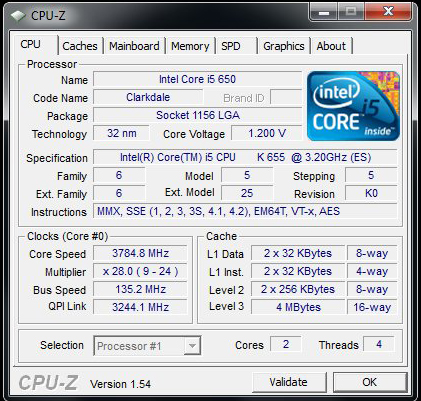
Next up, maximum stable overclocks:
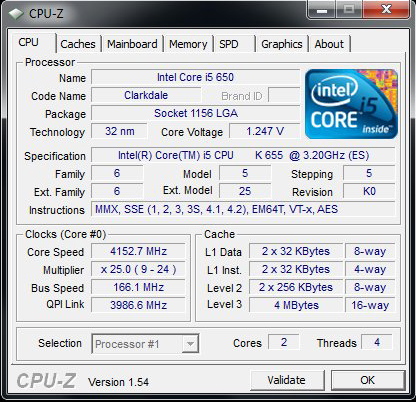
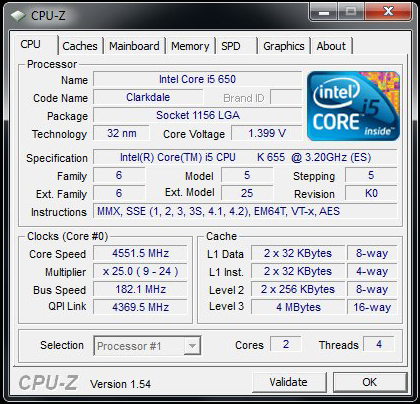
We’re often criticized for being a little brief and thin on overclocking results for our processor launch articles so we’re going to break things down a little further today and take a look at sensible operating points and compare the power curves of different processors.
VID, VCC & Relative Frequency Scaling
First up, let’s take a look at the stock voltages programmed by Intel (VID) for each processor on test today, and the required voltage under full Linpack load at stock frequency and 4.55GHz.
Do note, that actual load voltages will vary from board to board depending upon loadline resistance, Voffset and Vdroop. For the uninitiated, Voffset is difference between the applied voltage and the actual idle state voltage, while Vdroop is the level of voltage sag between idle and full load processor states. These safety margins are necessary to ensure that the real time voltage level (VCC), does not breach the applied VID for extensive periods or by excessive levels (acceptable overshoot margins are stipulated in the Intel white papers). Further explanation of these design principals is provided here.
| Processor | Stock Frequency | Turbo Mode | Stock VID | Stock VCC (Load) | VCC @ ~4.55GHz (Load)* |
| i3-540 | 3.06GHz | N/A | 1.0500V | 1.029V | 1.323V |
| i5-655K | 3.20GHz | 3.46GHz | 1.2125V | 1.190V | 1.378V |
| i5-661 | 3.33GHz | 3.6GHz | 1.1625V | 1.143V | 1.306V |
*Overclocked voltage requirements using water-cooling.
At first glance, the i5-661 stands out for having a relatively low stock VID in relation to its maximum single-threaded Turbo mode speed of 3.6GHz. That’s 160MHz higher than the i5-655K with a small reduction in voltage. Not only that, but it manages to reach 4.55GHz using the lowest VCC of these three test samples.
Here’s a graphical representation of how each processor scales frequency versus voltage, normalized to each part's stock VCC:
Of course, this is but a mere portion of the story, what we’re interested in is the power consumption of each processor at equivalent frequencies and how that has an impact on frequency scaling given various forms of cooling.


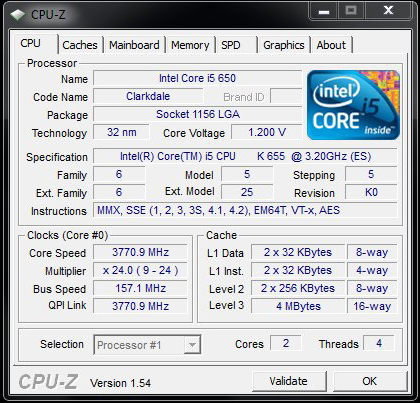
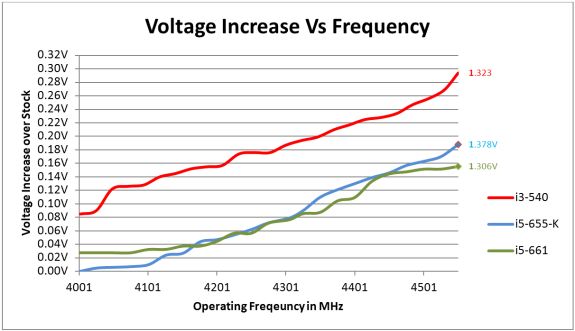








51 Comments
View All Comments
Rajinder Gill - Friday, May 28, 2010 - link
Hi,The actual "break point" is at 3.962GHz to be precise. A 9W step to 3.986GHz, followed by a 11w step to 4.009GHz. Anything higher than this and I'm loading up at 85C (according to DTS) and I can't get Linpack stable. I've extended x to show the 4.009GHz point. We'll endeavour to plot some more curves featuring some of the parts you mention if time allows.
Thanks!
Raja
Spenny2112 - Friday, May 28, 2010 - link
This only further confirms the change that the pc industry will be undergoing in the near future.Interitus - Friday, May 28, 2010 - link
Why does this make any sense on the 1156 platform? Intel created 2 different platforms, 1366 enthusiast and 1156 mainstream. Why is this on 1156 and not on 1366? Does that make any sense since 1366 is supposed to be the enthusiast/OC/hardcore version?Keep in mind I'm not arguing the viability of either socket. I'm just saying that Intel designed 1366 to be the high end, so why do this for the low end, but keep the unlocked chips for 1366 at $1k?
blandead - Friday, May 28, 2010 - link
1 reason that comes to mind first... $$$$$$2 this isn't targeted toward the enthusiast overclocker
the ones buying 1366 don't need unlocked multipliers to reach 4ghz or 1800+mhz ram speed.
I'm an AMD fanboy and my friend bought an i7 930 and 2000mhz ram and asked me to overclock it. I've never played with an i7 before, but surprisingly it was easy as cake to get it to 4.1ghz and 1850mhz ram on air and still have QPI overclocked past 6.4 dont quite remember i dont use the i7. Point is, with those achievements on a 930 I don't see a need for unlocked multiplier or k series.
TheBLK - Friday, May 28, 2010 - link
So why the messing BLK ????geokilla - Friday, May 28, 2010 - link
That's a huge jump in power consumption... But then these are engineering samples. I hope the retail ones will be better.Jamahl - Friday, May 28, 2010 - link
"This is another of those situations where we’ve had to make an eleventh-hour conference call with Intel to work out what and who these processors are aimed at."How about you make your own minds up instead?
First Anand did it with the awful clarkdale now you are doing it with these similarly awful cpu's. If intel gives you shit, TELL US ITS SHIT. Take a look around the web and see how poorly these cpu's were received elsewhere.
My respect for AT is at an all time low - there is no longer any pretence that you aren't an intel shill.
Hrel - Friday, May 28, 2010 - link
But it's about F***ing time!zodiacfml - Friday, May 28, 2010 - link
simply, the new unlocked chips does not offer real advantages compared to their siblings except for dynamic overclocking and the one posted which is little better turboboost speeds.yet, the additional cost compared to the performance of AMD's black edition processors is not that reasonable.
sergiu - Saturday, May 29, 2010 - link
It would have been nice if we could see the power consumption when dual cascade cooling has been used (both in stock and overclocking). I'm interested to see the leakage scalling with temperature!